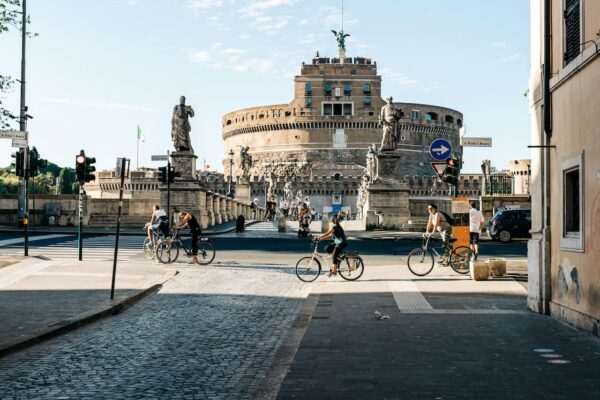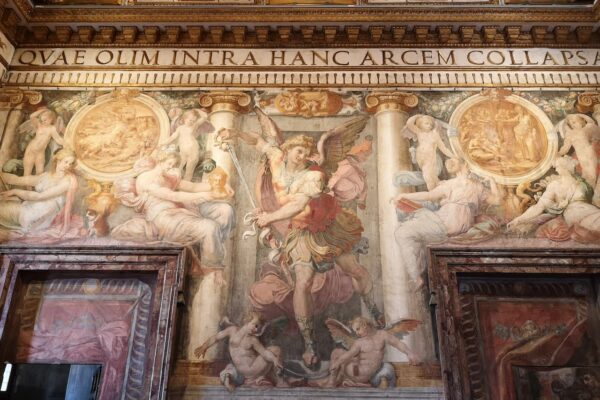Like many of the places where history can still be felt, Castel Sant’Angelo is a monument of light and shadow.
With this post we will delve into its darkest part, where the old walls witnessed heartbreaking cries and screams. Are you ready to follow me into the historic prisons of Castel Sant’Angelo?
On this tour, I will tell you the history of the prisons and the illustrious prisoners who were held there. In addition to descriptions of the cells, including the famous Cagliostra, you will find useful information for your visit to the Castle’s most secret spaces.
And don’t worry, as always I will also tell you the most interesting anecdotes and curiosities about this fantastic monument. Continue reading and follow me into the darkness of the secrets of Castel Sant’Angelo!
HOLD ON! Before you start reading, I ask you to be careful: the historical prisons are not always open, and given their fame, visiting them means a long queue at the ticket office. To enter this part of the castle and skip the queue, I recommend you buy your ticket online. Click below to book your entrance and enter Castel Sant’Angelo without unnecessary waiting.
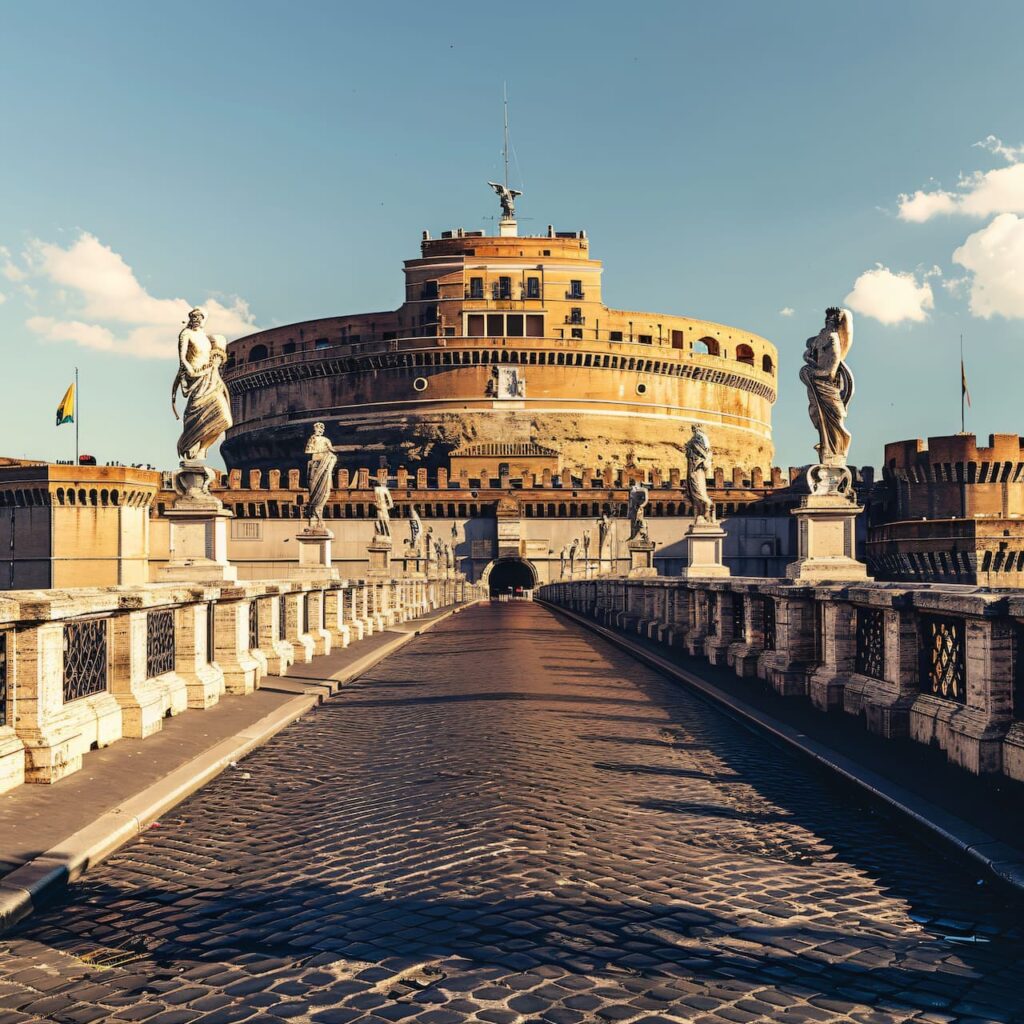
Castel Sant’Angelo Rome Tickets: Quick Access
Buy online. Choose your preferred time. Visit Rome’s Castel Sant’Angelo, Hadrian’s Tomb, the fortress and much more.
You can cancel free of charge up to the day before the visit.
Prisons of Castel Sant’Angelo: Description
Contents
As you will already know if you have read my post on the history of Castel Sant’Angelo, the Mole Adriana, from a funeral mausoleum, was transformed very early on into a fortress.
As early as the beginning of the 6th century, the Ostrogothic ruler Flavius Theodoric the Great decided to use the fortress as a state prison.
But even when Byzantine rule ceased and Rome returned under the temporal power of the pontiff, the castle did not lose its function as a prison. Indeed, it is to Alexander VI Borgia that we owe a remarkable expansion of the prison structure that we can still admire today.
Famous for having ‘hosted’ (and sometimes seen die) many illustrious personalities, the historic prisons are accessible from the Alexander VI Courtyard, also known as the Theatre Courtyard.
Like other areas of the Castle, however, the prisons are not always open to the public, but it is possible to visit them during special openings.
If you too are looking forward to the next opening and want to get a preview of what you will see, be sure to read on!
Visit the Prisons of Castel Sant’Angelo
As I mentioned in the last paragraph, access to historical prisons is through the Court of Alexander VI.

A small doorway leads to a staircase that leads to the large rectangular room, known as the Parlatoio, where the prisoners of the Pontiff’s State were interrogated and… made to speak, very often through the torture.
Some of the instruments are still preserved in special cases, while illustrations show us the torture techniques used by their torturers.

Beyond this room is a dark and narrow semi-circular corridor onto which three narrow cells open. There, a flood of light penetrates through the narrow gratings overlooking the courtyard. On the floor of these, protected by grates, we can see some shafts that have brought to the surface the ancient Roman wall.
Next, a small passageway leads to the last two carceri, also lit only by tiny openings in the courtyard. The last of these is famous for having ‘hosted’ the Florentine artist Benvenuto Cellini for almost a year.
The small compartment that, as we ascend, we encounter on our right, is precisely the outdoor latrine from which, according to the famous story I will report later, the artist would have managed to evacuate.
To the left is the Oliare, the room where oil was stored in special terracotta jars.

Also visible from the prisons is the large window of the Justice Room, the place where death sentences were read to the inmates of Castel Sant’Angelo.
Prisons of Castel Sant’Angelo Rome: Curiosities
The infamous cell: Sammalò

The infamous cell: Sammalò
No matter how cramped the other prisons we have mentioned, the most feared cell inside Castel Sant’Angelo was located behind the corner bastion San Marco.
It was so narrow that the condemned man was thrown into it from above and, having no room to lie down, sit or stand, was forced to lie bending on his knees.
Originally, the cell was one of the spaces in the central hall of Hadrian’s Mausoleum, but in the Middle Ages it was converted into a secretory.
From the helical ramp of Castel Sant’Angelo the cell is still visible. The name is said to be due to the design of “San Marocco” which, when mispronounced, became the “Sammalò” that even Benedetto Cellini mentions in his memoirs.

Benvenuto Cellini’s famous escape

Benvenuto Cellini escapes from Castel Sant’Angelo
The Florentine sculptor, writer and goldsmith, famous not only for his works but also for his restless soul, was incarcerated in 1538 on charges of having stolen property from the Church during the Sack of Rome by the Lanzichenecchi.
But, as is easy to imagine, the artist did not sit still to serve his sentence: One night when the Castle was celebrating Corpus Christi, Cellini, after forcing open the cell door with pincers he had taken from his jailer, descended from the San Giovanni bastion using the classic method of knotted sheets.
The landing was not the smoothest, causing him to suffer a fracture of the leg. The artist nevertheless managed to escape and take refuge with Cardinal Cornaro, who, however, shortly afterwards returned him to the Pope.
Back in Castel Sant’Angelo, this time in an even more cramped and dark cell, Cellini took advantage of the only half-hour of daylight to read the Bible. On one wall of the cell there is still today a glass pane protecting the drawing of a resurrected Christ, which the artist, in his famous autobiography “Vita”, attributes to himself.
He was pardoned by the pope and discharged from prison in December 1539 through the intercession of Cardinal Ippolito II d’Este and the King of France.
A luxury prison: the “Cagliostra”
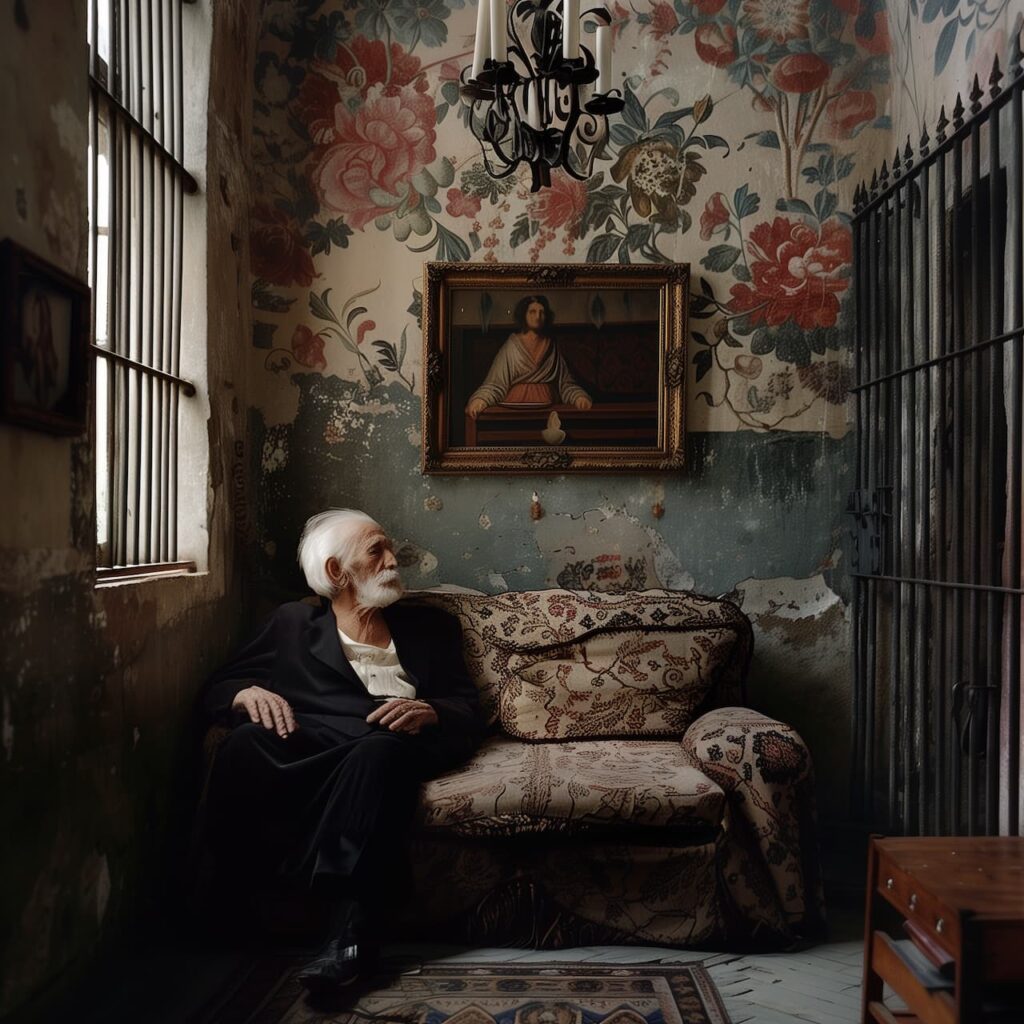
The ‘Cagliostra’ luxury cell
Can a cell be named after a prisoner? Sometimes yes, and this is the case of the Cagliostra;
This room was built in 1543 together with the underlying Loggia of Paul III. Initially, its arches opened towards the borgo di Prati, but in the XVIII century they were walled up to convert the room into a prison for prisoners of conscience.
It was indeed here that, in 1789, the Italian adventurer, esotericist and alchemist Giuseppe Balsamo Conte di Cagliostro was imprisoned by the Inquisition for about a year.
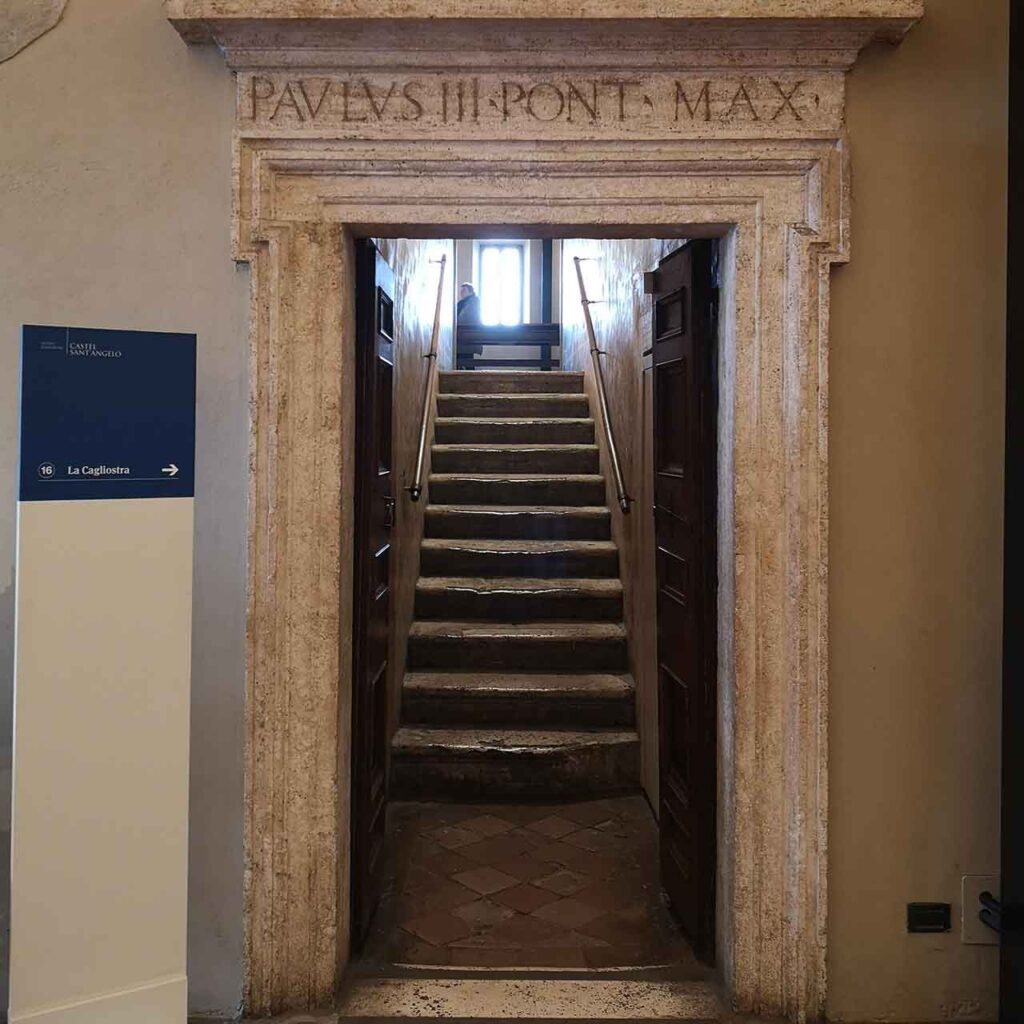
The small apartment consists of three rooms: a large, central one and two side rooms.
From the heraldic emblems of Paul III, depicted in the centre of the vaults, the two small rooms are named Gabinetto del Delfino e della Salamandra and Gabinetto della Cicogna.
The grotesque decoration of the interior walls, in typical Renaissance style, depicts a landscape inhabited by celestial figures and bears the signature of the illustrious painters Luzio Luzi and Perin del Vaga.

Here Cagliostro remains patiently awaiting trial. Tried for heresy, as well as for his membership of a Masonic lodge, he was then condemned to life imprisonment and transferred to the Fortress of San Leo, where he died a few years later.
Famous Prisoners
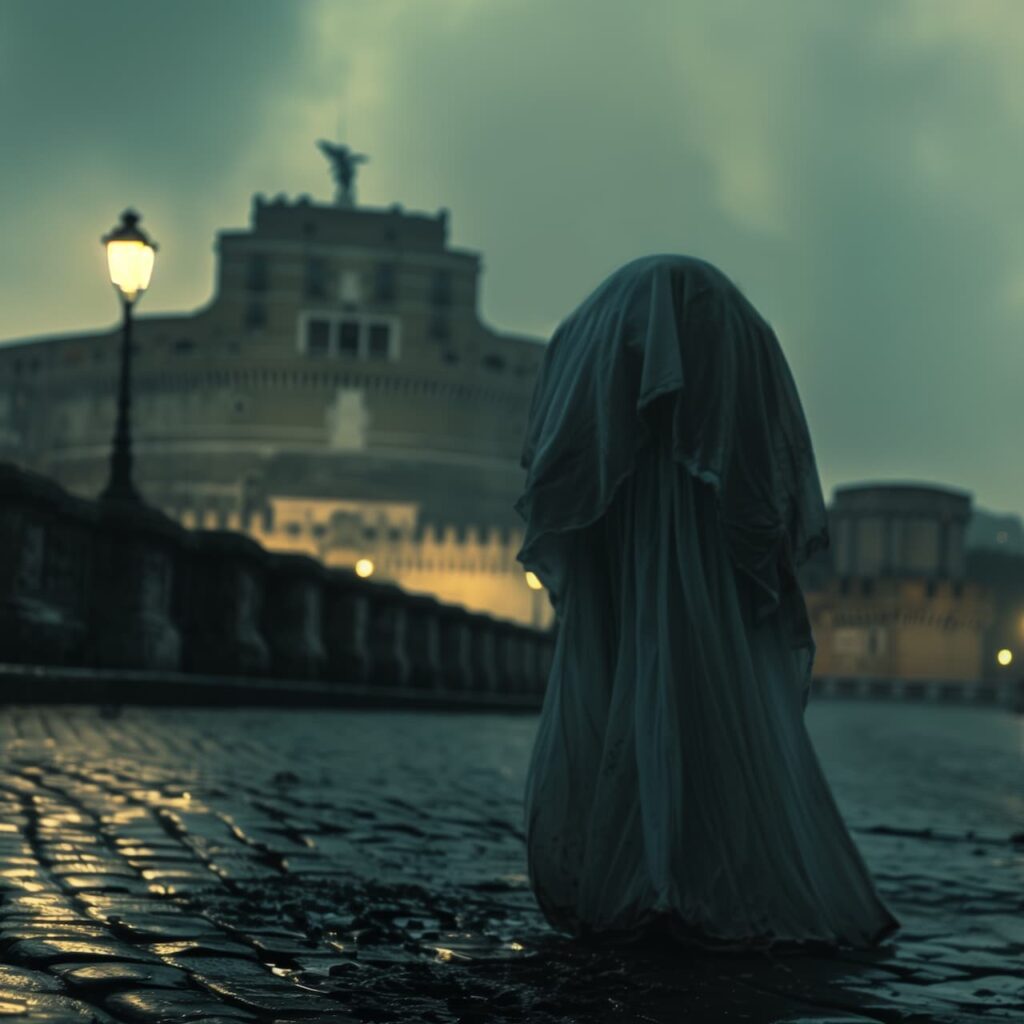
Headless Ghost by Beatrice Cenci
Who was imprisoned in the Castel Sant’Angelo prison? In addition to Benvenuto Cellini and the Count of Cagliostro, among the illustrious prisoners of Castel Sant’Angelothe humanists Platina and Pomponio Leto are often mentioned, the philosopher Giordano Bruno and the young Beatrice Cenci (whose full story I recommend in my post on the curiosities of Castel Sant’Angelo).
An equally compelling story concerns Cardinal Giovanni Battista Orsini, imprisoned here on charges of attempting on the life of Alexander VI.
The cardinal’s mother and mistress, united in their fear for the fate of their beloved, came before the pontiff with an enticing offer: a rare and precious pearl in exchange for the cardinal’s freedom. Probably taking advantage of the Borgias’ well-known weakness for pearls, they thus tried to undermine the torturer of their kinsman.
At first the plan appeared to work. The pope, in fact, accepted the offer: he took the pearl and, after having justified him, returned the cardinal’s body to his affections!
Castel Sant’Angelo Prisons: Tickets
The prisons of Castel Sant’Angelo in Rome can only be visited on the occasion of extraordinary openings to the public and special guided tours, such as the Guided tour of the Secret Castle, a project conceived by the Museum Pole of Lazio that makes visible some areas of the National Museum of Castel Sant’Angelo that are otherwise closed to the public.
However, at the moment, the prisons are closed, and the guided tour suspended until a later date.
If you wish to visit the other areas of the castle, be sure to purchase a entrance ticket to the National Museum of Castel Sant’Angelo, so you can enter skipping the queue at the ticket office.

Castel Sant’Angelo Rome Tickets: Quick Access
Buy online. Choose your preferred time. Visit Rome’s Castel Sant’Angelo, Hadrian’s Tomb, the fortress and much more.
You can cancel free of charge up to the day before the visit.
Rome Prisons: Frequently Asked Questions

Tosca jumps from Castel Sant’Angelo
In addition to Benvenuto Cellini and the Count of Cagliostro, the illustrious prisoners of Castel Sant’Angelo often include the humanists Platina and Pomponio Leto, the youngBeatrice Cenci, the philosopher Giordano Bruno and the cardinal Giovanni Battista Orsini.
The Tosca, heroine of the historical drama by Victorien Sardou and the opera based on Puccini, in the last act throws herself from Castel Sant’Angelo where her lover, the painter Mario Cavaradossi, has just been deceived.
In addition to the cenera of the emperor Adrian himself and his wife, Vibia Sabina, the mausoleum houses those of Antoninus Pius, his wife Annia Galeria Faustina and their children, of Lucio Aelius Caesar, of Commodus, of Marco Aurelio and three of his sons, of the emperor Settimio Severo, of his wife Giulia Domna and sons Geta and Caracalla.
Inside the Castel Sant’Angelo, you can still admire the Tomb of Hadrian, the circular staircase, the Papal lodgings, the frescoes, the Campus of the Capital Executions, the Grande Loggia, the bastions, the well-preserved fortress rooms, and much more.
Prisons of Castel Sant’Angelo: Conclusions
Here we finally re-emerge from the darkness of the secrets of Castel Sant’Angelo. Here ends our journey of deepening this very special and mysterious part of Rome.
Starting with the indispensable historical background, I wanted to describe the area of the historical prisons in detail, giving you a foretaste of what you might see if you decide to visit Castel Sant’Angelo.
I told you about the many historical curiosities and anecdotes concerning these ancient prisons, and there was no shortage of opportunities to smile about the true or legendary adventures that had the dungeons as a backdrop.
We met together with the illustrious characters who have passed through here as prisoners, but especially as prisoners, and I answered the most frequently asked questions.
If you need more information, leave a comment below; if you would like to visit the Castle, purchase your entrance ticket and skip the queue at the ticket office.

